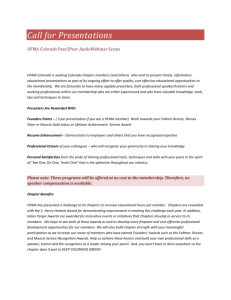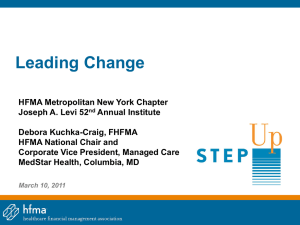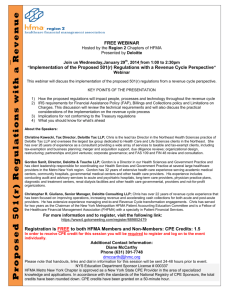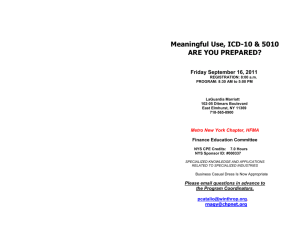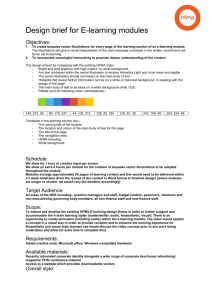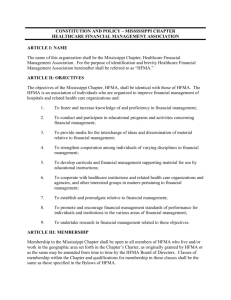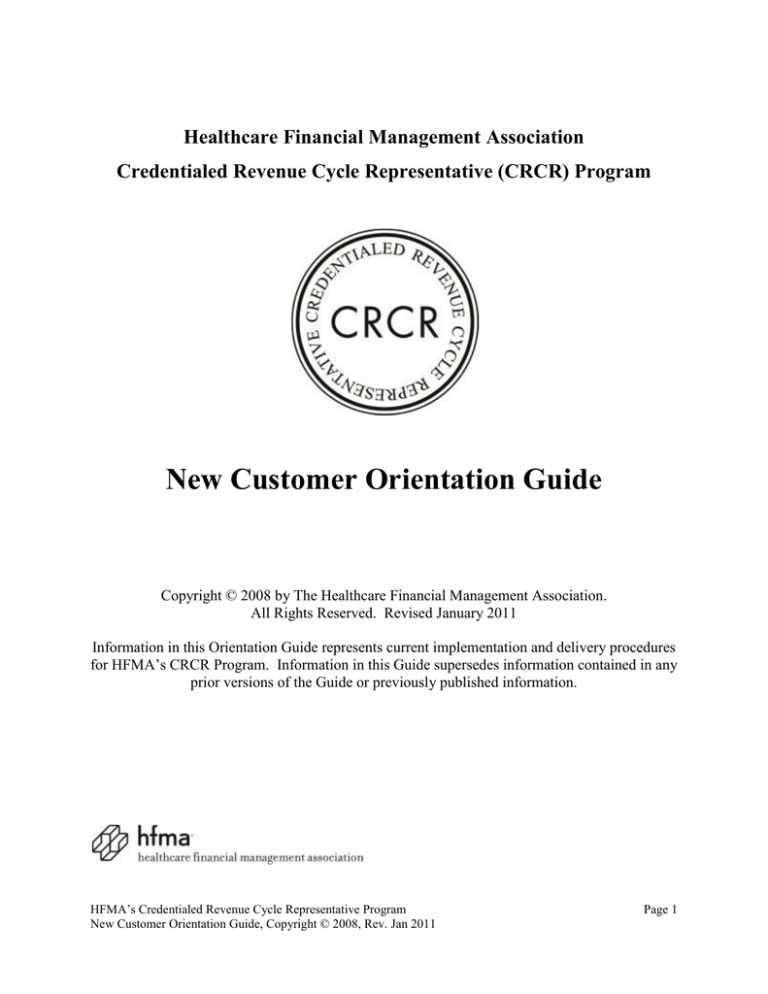
Healthcare Financial Management Association
Credentialed Revenue Cycle Representative (CRCR) Program
New Customer Orientation Guide
Copyright © 2008 by The Healthcare Financial Management Association.
All Rights Reserved. Revised January 2011
Information in this Orientation Guide represents current implementation and delivery procedures
for HFMA’s CRCR Program. Information in this Guide supersedes information contained in any
prior versions of the Guide or previously published information.
HFMA’s Credentialed Revenue Cycle Representative Program
New Customer Orientation Guide, Copyright © 2008, Rev. Jan 2011
Page 1
TABLE OF CONTENTS
SECTIONS
PAGE
1.
INTRODUCTION ...................................................................................................................... 3
2.
FOR THE ORGANIZATIONAL ADMINISTRATOR .................................................................... 5
3.
4.
2.1
YOUR ROLE ............................................................................................................. 5
2.2
PROGRAM OVERVIEW .............................................................................................. 6
2.3
SELECTING PARTICIPANTS ....................................................................................... 7
2.4
RESERVING THE TESTING ROOM ............................................................................. 8
2.5
PREPARING TERMINALS FOR TESTING ..................................................................... 8
2.6
ADMINISTERING THE CRCR EXAMINATION .............................................................. 8
FOR PARTICIPANTS ......................................................................................................... …10
3.1
PROGRAM OVERVIEW ........................................................................................ …10
3.2
YOUR ROLE ....................................................................................................... …10
3.3
ABOUT THE STUDY GUIDE................................................................................. …10
3.4
BEFORE THE EXAM ............................................................................................ …11
3.5
ABOUT THE EXAM ............................................................................................. …11
3.6
STUDENT AFFIDAVIT.......................................................................................... …11
APPENDIX: SELECTING PROCTORS .................................................................................. …16
HFMA’s Credentialed Revenue Cycle Representative Program
New Customer Orientation Guide, Copyright © 2008, Rev. Jan 2011
Page 2
INTRODUCTION
The Healthcare Financial Management Association’s (HFMA) Credentialed Revenue Cycle
Representative (CRCR) Program consists of an online, interactive study guide and timed credentialing
exam developed by HFMA and supported by the MC Strategies learning management system. The
CRCR Program serves to validate a national level of achievement for a body of knowledge within the
healthcare revenue cycle arena for revenue cycle staff and associated departments. Upon successful
completion of the exam, participants earn the designation CRCR.
Your organizational license allows for the credentialing of a group of staff for the duration of your
contract. Staff may re-test as many times as needed to obtain the credential or to maintain it. The CRCR
Program is flexible. Maintenance of the designation is determined by your organization; there are no
formal maintenance requirements by HFMA. HFMA updates the study guide and exam annually. It is to
your benefit to have staff re-test periodically. There are no additional fees involved for testing or retesting. Members and non-members of HFMA are eligible for the CRCR designation.
There are three (3) important roles involved in the implementation and delivery of the CRCR Program.
These roles are filled by your employees and will need to be assigned. The following is a brief overview
of these roles:
1. Organizational Administrator (OA): This individual is responsible for overseeing the
credentialing process for the organization’s staff. The OA may be a team lead or within the
training and development department.
2. Participants/Students: These individuals take the CRCR exam and are seeking the CRCR
designation. Participants should be junior to supervisory level staff and may work within any
revenue cycle related department. HFMA recommends participants have a minimum of 1-2 years
of healthcare experience prior to sitting for the CRCR exam.
3. Proctors (when available): Proctors supervise the participants during testing and are responsible
for upholding exam integrity.
HFMA’s Credentialed Revenue Cycle Representative Program
New Customer Orientation Guide, Copyright © 2008, Rev. Jan 2011
Page 3
The following orientation guide provides detailed information and preparatory reading for each of
these roles and the respective sections should be distributed in advance to these groups with an
email or memo explaining the program. Furthermore, it is suggested that Organizational
Administrators read the sections assigned to Participants.
Should any questions about implementation arise, please direct them to your MC Strategies’ Client
Service Representative who has the ability to achieve resolution through a variety of resources available.
If you have any comments or questions about the program or this guide, please send them to:
The Healthcare Financial Management Association
Office of Professional Development
Two Westbrook Corporate Center, Suite 700
Westchester, IL 60154
E-mail: crcr@hfma.org
Best of Luck!
HFMA
HFMA’s Credentialed Revenue Cycle Representative Program
New Customer Orientation Guide, Copyright © 2008, Rev. Jan 2011
Page 4
FOR THE ORGANIZATIONAL ADMINISTRATOR
2.1 YOUR ROLE
The Organizational Administrator (OA) oversees the implementation and delivery of HFMA’s CRCR
Program within the company. Specific responsibilities include:
Serving as your organization’s point-of-contact, externally and internally:
»
Externally: Teaming with MC Strategies’ Client Service Representative (CSR) on how to access
the program, set-up participants in the system, etc. (An introduction to your CSR will be made
for you, if not already known.);
»
Internally: Communicating with the larger group of business leaders to build awareness of the
program’s availability and teaming with them to identify participants; Notifying all departments
(IT, Facilities, etc) involved in the implementation and delivery of the program and obtaining
resources as needed;
Introducing the CRCR program to participants and providing them with information from this guide
and any company-specific information. Monitoring participants’ progress over the study period;
Confirming the number of participants ready to test (within each group if applicable), scheduling all
participants’ examinations, and communicating exam location and time to participants. (Participants
must notify the OA if they need to cancel or reschedule.) Additionally, notifying all confirmed
participants of the need to bring a valid photo ID (employee badge or driver’s license), a calculator
(can not be on a cell phone), and writing utensil. Cell phones and/or other recording devices are not
permitted in the testing room;
Arranging the testing environment – reserving the computer room/lab (see Section 2.5 below),
teaming with your company’s IT support person to prepare the terminals for testing (see Section 2.6
below) and ensure someone is “on call” the day of testing including how he/she may be reached,
communicating with your MC Strategies’ CSR to make him/her aware of the test date(s) and time(s),
etc. Note: Please work with your CSR to confirm technical coverage if test start and/or end times are
outside of MC Strategies’ normal business hours;
Collecting one copy of successful participants’ certificates (post-exam) for their personnel files;
Reporting any misspelled participant names to your MC Strategies Client Service Representative to
ensure certificate accuracy;
(FOR NEW LMS CUSTOMERS ONLY) Advising participants to change their system passwords to
ones they can remember in advance of exam date/time;
HFMA’s Credentialed Revenue Cycle Representative Program
New Customer Orientation Guide, Copyright © 2008, Rev. Jan 2011
Page 5
(FOR NEW LMS CUSTOMERS ONLY) Providing a brief overview of the LMS to participants in
advance.
Specifically, your MC Strategies CSR will provide you with an orientation on the following
responsibilities:
Entering participants in the LMS, assigning/editing the study guide modules and deadline dates, and
assigning/editing exam dates. Grouping participants into departments if desired;
Administering the CRCR examination
Viewing reports in the LMS;
Tracking participants’ progress by module;
How to extend a participant’s exam time as a result of computer/internet failure.
2.2 PROGRAM OVERVIEW
The CRCR Program involves an online, interactive study guide and a timed examination. Access to both
will be provided by your designated MC Strategies CSR. The study guide takes approximately 12-15
hours to complete and consists of seven chapters, divided among 3 “module” links. The OA should
ensure that participants have all three modules assigned to them.
Link 1: “HFMA Revenue Cycle Credentialing – Module 1”
»
Chapter 1 – Compliance
»
Chapter 2 – Patient Access
Link 2: “HFMA Revenue Cycle Credentialing – Module 2”
»
Chapter 3 – Claims Processing
»
Chapter 4 – Account Resolution
Link 3: “HFMA Revenue Cycle Credentialing – Module 3”
»
Chapter 5 – Cash
»
Chapter 6 – Financial Management
»
Chapter 7 – Support Departments
For a brief demonstration of the study guide and an overview of its features, please visit:
www.mcstrategies.com/HFMA-CRCR/demo/HFMA CRCR DEMO.wmv
As soon as participants have completed their studies and are ready, you may schedule the examination in
your company’s computer room. The examination is 3 hours in length and consists of 150 multiple
HFMA’s Credentialed Revenue Cycle Representative Program
New Customer Orientation Guide, Copyright © 2008, Rev. Jan 2011
Page 6
choice questions. Questions appear one at a time and are drawn randomly from the question bank
providing individual candidates a unique exam.
The exam is weighted by chapter, as determined by the CRCR Advisory Committee: 43% of questions
address Patient Access, 43% address Patient Accounts, and the remaining 14% examine other areas. The
exam provides real-time scoring - 75% is the required passing score. Questions and candidate responses
are not disclosed. Participants who pass (75%) or pass with distinction (90%) will receive a temporary
certificate to print after finishing their exams. A formal certificate and congratulatory package will be
provided by MC Strategies directly to successful individuals. CRCR designation pins will be provided
to the Organizational Administrator by HFMA. The organization decides how the pins will be
awarded to successful candidates, e.g. by the immediate supervisor, at a recognition function, etc.
Questions regarding the pins should be directed to HFMA at 1-800-252-4362, ext.311 or by email to
certification@hfma.org
Unsuccessful candidates will be directed to inform their supervisors and request a rescheduled exam
date/time. As with any exam, preparation should not be necessarily limited to the CRCR study guide.
Participants are encouraged to create study groups and/or organizations are encouraged, but not required,
to provide resources to increase the probability of success.
Three interventions are required before a participant can gain access to the examination: 1) An exam date
must be assigned to the participant in the system; 2) An administrator must “unlock” the exam for the
participant; and 3) The participant must provide his/her user-ID and password.
2.3 SELECTING PARTICIPANTS
The CRCR Program is designed for junior to mid-level staff working within any revenue cycle related
department. (The more departments that complete the CRCR Program, the greater the likelihood of
shared understanding.) HFMA recommends participants have a minimum of 1-2 years of healthcare
experience prior to sitting for the CRCR exam. Please note: HFMA also offers the Certified Healthcare
Finance Professional (CHFP) designation, a certification more suited for upper-management (e.g.
Director and above).
HFMA’s Credentialed Revenue Cycle Representative Program
New Customer Orientation Guide, Copyright © 2008, Rev. Jan 2011
Page 7
2.4 RESERVING THE TESTING ROOM
Ideally the CRCR exam should take place in a quiet computer room or lab apart from the demands of
daily operations. However, if reserving this room is a problem due to other company projects, the
Organizational Administrator may consider using a work area of cubes, all within close proximity, on a
quieter floor. Traffic around the area should be re-routed and signs placed on doors notifying others of
the exam in process. Phones within the quiet work area of cubes should be disconnected so participants’
are not disturbed.
2.5 PREPARING TERMINALS FOR TESTING
The Organizational Administrator needs to team with an IT support person to prepare the computer
terminals for testing. We recommend that the following activities be done one (1) week prior to the first
scheduled exam to ensure a positive experience for all participants:
Stress test a number of terminals by running several at the same time. Check for any delay in
response times. (Tip: Exams over the lunch hour should be avoided as internet usage may increase
significantly during this time and considerably slow terminal response time.);
Check all hard line data connections prior to participants’ arrival to ensure jacks are well connected.
Confirm there will not be any software pushes or upgrades scheduled for the night before the exam,
which may affect terminals’ function/set-up;
Verify all terminals have the latest Internet Browser;
Ensure Java scripts are updated.
2.6 ADMINISTERING THE CRCR EXAMINATION
HFMA prefers that the CRCR examination be proctored whenever possible. Instructions for the use of
proctors are included as an appendix. HFMA understands that organizations with geographically
dispersed staff may not be able to have a proctor physically present for each CRCR examination
administration. It is acceptable therefore to have the Organizational Administrator serve as an electronic
proctor and administer the examination.
When no proctor is available, the Organizational Administrator serves as an electronic proctor and is
required to abide by the following examination administration protocols:
HFMA’s Credentialed Revenue Cycle Representative Program
New Customer Orientation Guide, Copyright © 2008, Rev. Jan 2011
Page 8
Prior to the Examination
1) Uphold the confidentiality of the exam contents. Examinations are to be kept strictly confidential
and may not be previewed or recorded in any capacity. Candidates are asked to read and accept
confidentiality, non-disclosure statement at the beginning of the exam.
2) Confirm with each candidate the testing date, time and location. Set the availability of the
examination only for the specified date and time. Candidates should be allotted only one attempt
at the examination on the specified testing date. The candidate should be allotted three (3) hours
to complete the examination.
3) Verify the list of all participants for a given examination setting and that the candidates have their
unique user ID and passwords to log-into the exam system at the assigned time.
4) Confirm the MC Strategies contact person is available during the examination in the event of
network difficulties. Confirm with internal IT staff that all IT equipment is ready and that
candidates can navigate to the LMS log-in page.
Examination Day
1) Electronically unlock the CRCR exam for scheduled candidates using the Organizational
Administrator ID and password
2) Electronically sign the Proctor Affidavit.
3) Electronically check each candidate’s name; click “unlock” at the bottom of the page.
4) Instruct testers to log into their “Personal Page” and click on the “My E-Learning Lessons” tab.
5) Confirm with testers that they see “HFMA Credentialed Revenue Cycle Representative Exam” in
their e-learning lessons.
6) Assist any candidates that receive a “locked” message.
7) Instruct candidates to read and accept the “Student Affidavit.”
8) Instructor the candidates on the proper protocols for the examination requesting assistance during
the exam. Reiterate: there are three hours are allotted to complete the exam; 150 multiple choice
questions; you cannot return to questions once submitted; the exam has an auto-timer and will
shut down when the three hours is over.
9) Instruct the candidates to read the “Student Instructions”. When candidates are ready, instruct
them to click on “Start Exam”.
10) Identify any candidates experiencing computer problems and provide assistance
11) Address candidate post-exam questions, e.g. printing certificates, re-examination, etc.
HFMA’s Credentialed Revenue Cycle Representative Program
New Customer Orientation Guide, Copyright © 2008, Rev. Jan 2011
Page 9
FOR PARTICIPANTS
3.1 PROGRAM OVERVIEW
CRCR is a credentialing program which consists of an online, interactive study guide and timed
credentialing exam developed by HFMA and supported by the MC Strategies learning management
system. The CRCR Program serves to validate a national level of achievement for a body of knowledge
within the healthcare revenue cycle arena for revenue cycle staff. Upon successful completion of the
exam, participants earn the designation CRCR.
3.2 YOUR ROLE
Congratulations! You have been selected by your organization’s leadership for the Healthcare Financial
Management Association’s Credentialed Revenue Cycle Representative (CRCR) program. Your role in
this process is to study and sit for the CRCR exam.
3.3 ABOUT THE STUDY GUIDE
The online, self study guide takes approximately 12-15 hours to complete and consists of seven chapters,
divided among 3 “module” links on your “Personal Page.” Your Organizational Administrator (OA) will
be made known to you and will ensure that you are granted access to all three modules. If you aren’t,
please contact him/her for assistance.
Link 1: “HFMA Revenue Cycle Credentialing – Module 1”
»
Chapter 1 – Compliance
»
Chapter 2 – Patient Access
Link 2: “HFMA Revenue Cycle Credentialing – Module 2”
»
Chapter 3 – Claims Processing
»
Chapter 4 – Account Resolution
Link 3: “HFMA Revenue Cycle Credentialing – Module 3”
»
Chapter 5 – Cash
»
Chapter 6 – Financial Management
»
Chapter 7 – Support Departments
There are “check your knowledge” questions within the chapters and “review questions” at the end of
every chapter. These are modeled after the exam questions to help you become more familiar with the
exam format however they are not graded nor submitted to anyone for review. They are only for your
benefit. You are encouraged to form study groups or seek out resources should you need additional help.
HFMA’s Credentialed Revenue Cycle Representative Program
New Customer Orientation Guide, Copyright © 2008, Rev. Jan 2011
Page 10
The study guide takes approximately 3 months to complete however this timeframe may be shortened or
lengthened depending on how your OA has structured your company’s program. When you have
completed the study guide, inform your OA. He/She will arrange a test date, time and location for you.
3.4 BEFORE THE EXAM
1) Confirm your test date, time, and location with your Organizational Administrator (OA).
2) Bring the following with you:
a) Calculator (cell phone calculators will not be allowed). Some questions require calculations.
b) Writing utensil. You will be given scratch paper and asked to turn it in to the OA at the end of
your exam.
c) Cell phones and/or other recording devices are not permitted in the testing room. You may not
receive or send any electronic communications during the examination.
3) Check in with your OA as soon as you arrive to the testing room.
3.5 ABOUT THE EXAM
The CRCR exam involves 150 multiple-choice questions covering the following topics:
Patient Access – 64 questions
Claims Processing, Account Resolution, and Cash - 65 questions
Compliance, Financial Management, and Support Departments - 21 questions
Questions will be presented one at a time, in random order, and will be numbered so you will know how
many questions you have completed. Read each question and the four possible answer statements
(A,B,C,D) carefully. Select the one statement you think answers the question best by clicking the radio
button next to the statement. If you decide to change your answer, simply click that answer’s radio
button. Only one statement can be selected per question. When you have chosen your answer, click the
“Submit” button in the lower, right hand corner of your screen to submit your answer and move to the
next question. Once you have hit “Submit” you will not be able to go back to a question to change your
answer nor will the system allow you to skip questions. A submitted answer is your final answer.
Should you have any computer problems during the exam, alert your OA you have a computer problem.
The OA will take the necessary steps to achieve resolution and if necessary, adjust your testing time.
Once the situation has been corrected, log-in again and click on the exam link. You will be taken back to
the last question on the screen prior to the technical issue. All previous exam responses will be
unaffected.
HFMA’s Credentialed Revenue Cycle Representative Program
New Customer Orientation Guide, Copyright © 2008, Rev. Jan 2011
Page 11
You are allowed 3 hours to complete the examination. Monitor your pace to ensure you see every
question. A timer is provided in the top, right hand corner of your screen. The exam will close
automatically in either of the following situations:
You complete all 150 questions within 3 hours, (OR)
The timer reaches 3 hours. Any unanswered questions will be marked as incorrect.
Once the exam closes, you will receive a message about your results. Regardless of results, please
proceed to the brief online evaluation that follows. This provides HFMA with feedback for continuous
improvement of the program.
For successful candidates who achieve a passing score (a minimum of 113 correct answers, or 75%) or a
passing with distinction score (a minimum of 135 correct answers, or 90%), a temporary certificate will
be provided after completing the online evaluation. Please verify the spelling and appearance of your
name on your certificate before leaving the room, as this is the way your name will appear on the formal
certificate. Notify your OA of any corrections needed. Proceed to log-out of the testing site, shut down
your computer terminal, and return both pages of scratch paper to your OA on your way out. Please
remember not to discuss the exam outside the testing room, in accordance with the Student Affidavit’s
terms of confidentiality. Once back at your desk, you may find your actual score (percentage) on your
“personal page” to the right of the exam link (under the Completed Lessons tab). Click on the exam link
to access your temporary certificate and print 2 copies; keep one for yourself and submit the other to your
OA. A congratulatory package with formal certificate (from MC Strategies) will be mailed to you 6-8
weeks later.
Candidates that do not successfully complete the exam will see the evaluation as the final screen. Please
complete the evaluation, log-out of the testing site and shut down your computer terminal. You may
work with your OA to reschedule your exam when you are ready. Please remember not to discuss the
exam outside the testing room, in accordance with the Student Affidavit’s terms of confidentiality.
3.6 STUDENT AFFIDAVIT
After logging in to the exam site, you will be prompted to electronically sign a Student Affidavit. Please
read this in advance of examination day so you are aware of your responsibilities as a participant.
HFMA’s Credentialed Revenue Cycle Representative Program
New Customer Orientation Guide, Copyright © 2008, Rev. Jan 2011
Page 12
Please read the following statements carefully and indicate your understanding and agreement by clicking
the “Accept” button.
1. I hereby apply to the Healthcare Financial Management Association ("HFMA") for examination
and issuance to me of a Credentialed Revenue Cycle Representative Certificate (“Certificate”) in
accordance with and subject to the procedures and regulations of HFMA. I have read and
understand the rules and procedures pertaining to the Credentialed Revenue Cycle Representative
Examination, as set forth in HFMA's Revenue Cycle Credentialing Program. I agree to
disqualification from examination; to denial of the Certificate; to denial of future eligibility for
any HFMA examination; and to forfeiture and redelivery of any Certificate granted me by HFMA
in the event that any of the statements or answers made by me in this application are false or in
the event that I violate any of the rules or regulations governing an HFMA examination. I
authorize HFMA to make whatever inquiries and investigations it deems necessary to verify my
credentials and my professional standing.
2. I understand that this application and any information or material received or generated by
HFMA in connection with this application or with the Certificate process will be kept confidential
and will not be released unless I have authorized such release or such release is required by law.
However, I understand that the fact that I have or have not been issued a Certificate, and the dates
on which the Certificate is valid, are matters of public record and may be disclosed. I allow
HFMA to use information from my application and subsequent examination for the purpose of
statistical analysis, provided that my personal identification with that information has been
deleted.
3. I understand that the content of HFMA’s examinations, and each of their items, are proprietary
and strictly confidential, and that the unauthorized retention, possession, copying, distribution,
disclosure, discussion, or receipt of any examination question, in whole or in part, by written,
electronic, oral or other form of communication, including but not limited to e-mailing, copying
or printing of electronic files, and reconstruction through memorization and/or dictation, before,
during, or after an examination, is strictly prohibited. I further understand that, in addition to
constituting irregular behavior subject to disciplinary action such as denial or revocation of the
Certificate, revocation of eligibility for future HFMA examinations, and disciplinary fines, such
activities violate HFMA’s proprietary rights, including copyrights, and may subject me to legal
action resulting in monetary damages.
4. I further understand that I can be disqualified from taking or continuing to sit for an examination,
or from receiving examination scores, and that I may be required to retake an examination if, at
HFMA’s Credentialed Revenue Cycle Representative Program
New Customer Orientation Guide, Copyright © 2008, Rev. Jan 2011
Page 13
its sole discretion, HFMA determines through OA observation, statistical analysis or any other
means available to it, that I was engaged in collaborative, disruptive, or other irregular behavior
before, during the administration of, or following, the examination, or if HFMA determines that
the integrity or validity of the examination otherwise is in question.
5. I further understand that, in some instances, while the evidence of irregularity is sufficiently
strong to cast doubt upon the validity of scores, such evidence may not enable HFMA to identify
the particular individuals involved. In any such circumstance, I understand that HFMA reserves
the right to withhold the scores of all candidates, including candidates not directly implicated in
the irregularity and, if necessary, to require all candidates to take an additional examination at a
later date under conditions which will ensure the validity of all scores.
6. I hereby agree to indemnify and hold harmless HFMA, its officers, directors, members,
examiners, employees, and agents, from any lawsuit, complaint, claim, loss, damage, cost or
expense (including attorneys' fees) arising out of or in connection with any action or omission by
any of them in connection with this application; the application process; the certification process;
any examination given by HFMA; any grade relating thereto; the failure to issue me any
certificate; or any demand for forfeiture or redelivery of such certificate.
BY CLICKING ON THE BUTTON ON THIS PAGE MARKED “ACCEPT,” I ACKNOWLEDGE AND
AGREE THAT I HAVE READ AND UNDERSTAND ALL OF THE ABOVE CONDITIONS, TERMS,
POLICIES, PROVISIONS, DISCLOSURES AND DISCLAIMERS, AND THAT I EXPRESSLY
AGREE TO BE LEGALLY BOUND BY THEM.
<<ACCEPT BUTTON>>
HFMA’s Credentialed Revenue Cycle Representative Program
New Customer Orientation Guide, Copyright © 2008, Rev. Jan 2011
Page 14
APPENDIX: SELECTING PROCTORS
Proctors supervise the participants during testing and are responsible for upholding exam integrity.
HFMA requires this person be manager-level or above, AND at least one level above the highest-level
participant taking the exam. Direct reporting relationships between proctor and candidate are highly
discouraged. HFMA prefers that Proctors be HFMA members but this is not a requirement. HFMA
suggests one (1) Proctor for every group of twenty (20) participants (maximum).
3.1 Program Overview
CRCR is a credentialing program which consists of an online, interactive study guide and proctored,
timed credentialing exam developed by HFMA and supported by the MC Strategies learning management
system. The CRCR Program validates knowledge of the healthcare revenue cycle arena for revenue cycle
staff and associated departments. Upon successful completion of the exam, participants earn the
designation CRCR.
3.2 Your Role
You have been chosen to serve as a Proctor in the delivery of the CRCR examination. The bulk of the
proctor’s responsibilities are executed on examination day however there are a few preparatory and
follow-up activities involved. In order to maintain the validity and confidentiality of the examination and
integrity of the CRCR designation, you are asked to follow these policies and procedures.
3.3 Policies
1) Once assigned, each proctor should make arrangements with his/her Organizational Administrator
(“OA”) regarding his/her availability to administer the test(s). If a scheduling conflict arises after an
exam day and time are confirmed, the proctor should notify the OA as soon as possible.
2) The proctor must uphold the confidentiality of every HFMA examination and must NOT:
a) Divulge the nature or content of any HFMA examination question, clarify or answer any
student’s question under any circumstances
b) Engage in any unauthorized communication during the examination that jeopardizes the integrity
of the exam or any student’s score.
3) The proctor must remain in the room for the entire exam (3 hours). If a proctor needs to leave, it
should only be for a brief period of time. During this time, a substitute proctor must be engaged. The
HFMA’s Credentialed Revenue Cycle Representative Program
New Customer Orientation Guide, Copyright © 2008, Rev. Jan 2011
Page 15
substitute proctor must be at least one level above the students. If a Manager or Director is taking the
exam, the substitute proctor should be from a different department to avoid conflict of interest.
Serving as a proctor for your direct reports is highly discouraged.
4) The proctor may assist students with computer problems (loss of internet connection, screen locking
up) should one arise during the exam. If the problem is with the computer, contact the facility’s
designated IT exam support. Your OA should have arranged for someone to be present or be “on
call.” If the problem is with the exam site, contact your MC Strategies’ Client Service Representative
directly. If this person is unavailable, any of the representatives should be able to help you.
5) Proctors are not allowed to obtain the CRCR after being designated a proctor.
3.4 Procedures
The Day Before the Exam
1) Confirm testing location and time (your OA will be able to confirm this for you)
2) Email students to remind them of exam location and time. Joe: I recommend the OA do this to
maintain control. This is also a lot for proctor if they have 20. If a student needs to cancel, see your
OA for a possible replacement. I recommend candidate notify. Notify all confirmed students of the
need to bring a valid photo ID (employee badge or driver’s license), a calculator (can not be on a cell
phone), and writing utensil. Cell phones and/or other recording devices are not permitted in the
testing room.
I recommend these directives come from OA – more of an organizational “authority”
to them.
3) Prepare to bring the following:
a) List of students (for check-in) you are scheduled to proctor that day
b) Writing utensil
c) Pad of 8 ½ x11 paper (for students’ scratch paper) – collect afterwards.
d) Your LMS username and password (You will be logging in to launch the exam links for the
students. This can only be done the day of the test.)
e) Phone number of your facility’s IT representative
f) Phone number of MC Strategies’ client services group
4) Obtain the contact information for your IT support and your MC Strategies Client Service
Representative. Your Organizational Administrator should be able to provide this information to you
in advance.
HFMA’s Credentialed Revenue Cycle Representative Program
New Customer Orientation Guide, Copyright © 2008, Rev. Jan 2011
Page 16
The Day of the Exam
1) Obtain keys for computer lab, if necessary.
2) Arrive at testing location at least 20-30 minutes in advance of exam start time and start-up the
required number of computers, in addition to one for yourself. Make sure all computers are working
and open the LMS log-on page at each terminal. (It helps to have a few additional computers ready,
should a student have issues with his/her terminal.)
Joe Question: does the exam provider have a
“reconnect” function should a candidate disconnect? We need to be able to reconnect a candidate at
the point where they fell-off. The proctor needs to know how to handle this situation as it is somewhat
nerve wracking for candidates. This reconnect feature also needs to record how much time has
elapsed so a candidate doesn’t get extra time in restarting.
3) As students arrive, check each student in by verifying his/her identity against a valid photo ID
(employee badge or driver’s license). Check his/her name against your list of students you have
scheduled for the exam that day.
4) Distribute 2 pages of 8 ½ x11 scratch paper to each student at check-in. Instruct students to write
their names on top of each page. Notify students of the need to submit both pages of scratch paper
before they leave the room.
5) Launch the exam for a group of students by following this process:
a) At one of the available computer terminals, log-in to the LMS using your proctor ID and
password.
b) Upon reaching your personal page, click on “Exam Proctor Utilities” or “My Exam Utilities.”
c) “Sign” the Proctor Affidavit by clicking on the box and the “Accept” button at the bottom of the
screen.
d) You will then see a list of students in your organization. Find every student who is present for
testing in the list. Confirm you have the right person and click the box next to his/her name.
Click the “unlock” button at the bottom of the screen. You will receive a prompt asking you to
confirm this action. Click OK. This will “unlock” the exam for the students. Please note: If you
have accidentally unlocked an exam for a student not present, please contact your MC Strategies
Client Service Representative to correct this issue.
e) Log-out when finished.
6) Instruct each student to log-in to the LMS with his/her username and password. Upon reaching their
“Personal Page,” the students should click on the “My Elearning Lessons” button. There, they should
see the following link: HFMA Credentialed Revenue Cycle Representative Exam. Ensure all students
HFMA’s Credentialed Revenue Cycle Representative Program
New Customer Orientation Guide, Copyright © 2008, Rev. Jan 2011
Page 17
can see the link. If so, have them click on it. (If not, follow the instructions above for unlocking the
exam. When you reach the list of students, verify that student has an “unlock” symbol next to his/her
name.) Students should agree to the “Student Affidavit” and review the “Student Instructions.” Have
students STOP at the Student Instructions before continuing.
7) Before they click “Start My Exam,” use the following information to set their expectations on what to
do at the end of the exam (since they will likely finish at different times).
a) After they see the message about their results, please have them complete the brief evaluation at
the end of the exam.
i)
For those who do not pass, the evaluation will be the last screen and the students can then
log-out.
ii) For those who pass, the certificate will be the last screen and they can then log-out. Passing
students are asked to verify their name on their certificate before they leave the room. The
certificate will be available for printing the next time they log-in to the site. (We ask they do
this so as not to disturb other students still testing.) Tell students to log-out before they leave
and to return their 2 pages of scratch paper.
8) Instruct students to start their exams.
9) Monitor students throughout exam and troubleshoot issues with exam functionality (loss of internet
connection, program locking up, etc) if necessary. Contact facility IT support or MC Strategies’
client services group, as necessary. Note: MC Strategies can help extend examination time if needed.
Once the situation has been corrected, the student will be able to return to the question on the screen
prior to the technical issue. Joe: add what the proctor is expected to do, e.g. you will be required to
relaunch the exam, reenter passwords, etc.
10) Before students leave, collect their scratch paper. Ensure you have both pages with the student’s
name.
11) After the last student has left the room, log out of the LMS program (if the student has not already
done so) and shut down all computer terminals.
12) Take all scratch paper with you and lock the computer lab.
13) Shred all scratch paper in your possession when you return to your desk. If you are not able to
destroy these pages immediately, please lock them in a secure location until you are ready to do so.
3.5 Proctor Affidavit
After logging in to the exam site, you will be asked to electronically sign a Proctor Affidavit. Please read
this in advance of examination day.
HFMA’s Credentialed Revenue Cycle Representative Program
New Customer Orientation Guide, Copyright © 2008, Rev. Jan 2011
Page 18
Please read the following statements carefully and indicate your understanding and agreement by clicking
the "Accept" button.
1. Role as Proctor: I hereby apply to the Healthcare Financial Management Association ("HFMA")
to serve as Proctor for HFMA's Credentialed Revenue Cycle Representative ("CRCR")
examination in accordance with and subject to the procedures and regulations of HFMA. I have
read and understand the Proctor's Policies and Procedures pertaining to the CRCR examination,
as set forth in HFMA's Revenue Cycle Credentialing Program. I agree to disqualification from
proctorship and to denial of future eligibility to proctor any HFMA examination in the event that I
violate any of the policies or procedures governing proctoring an HFMA examination. I authorize
HFMA to make whatever inquiries and investigations it deems necessary to verify my credentials
and my professional standing.
2. Security and Confidentiality of Materials: All testing materials, including but not limited to
examinations, parts of examinations, and individual examination items (Joe: these should NOT be
in the proctor’s possession., (the "Confidential Information") must be kept confidential and
secure. While these materials are in your possession, they must be locked in a secure location,
with access controlled only by you. Unless specifically authorized, you may not make copies of,
discuss, disclose, or otherwise disseminate, or assist or permit others to copy, discuss, disclose, or
otherwise disseminate, any Confidential Information and you may not to use the Confidential
Information for any purpose whatsoever except directly in connection with your service as a
Proctor. Neither the contents of these testing materials, nor the fact that you have them in your
possession, should be discussed or otherwise revealed to unauthorized persons. Further, your
promise of confidentiality will be in effect during the tenure of your service as a Proctor and at all
times thereafter, and is enforceable by law. At the completion of your service as a Proctor, or
sooner if requested by your Organizational Administrator, you must return to your Organizational
Administrator any and all copies of the Confidential Information and any additional information
or materials must be submitted by the author of the item. Examples of such materials include
photographs, video or audio tapes, digitized images, tables, charts, diagrams or illustrations.
3. Liability for Nondisclosure of Materials: I understand that the unauthorized retention, possession,
copying, distribution, disclosure, discussion, or receipt of the Confidential Information, in whole
or in part, by written, electronic, oral or other form of communication, including but not limited
to e-mailing, copying or printing of electronic files, and reconstruction through memorization
and/or dictation, before, during, or after an examination, is strictly prohibited. I further understand
HFMA’s Credentialed Revenue Cycle Representative Program
New Customer Orientation Guide, Copyright © 2008, Rev. Jan 2011
Page 19
that such activities violate HFMA's proprietary rights, including copyrights, and may subject me
to legal action resulting in monetary damages.
4. I hereby agree to indemnify and hold harmless HFMA, its officers, directors, members,
examiners, employees, and agents, from any lawsuit, complaint, claim, loss, damage, cost or
expense (including attorneys' fees) arising out of or in connection with any action or omission by
me in connection with my proctoring of any HFMA examination.
BY CHECKING THE BOX TO THE LEFT AND CLICKING ON THE BUTTON ON THIS PAGE
MARKED "ACCEPT", I ACKNOWLEDGE AND AGREE THAT I HAVE READ AND
UNDERSTAND ALL OF THE ABOVE CONDITIONS, TERMS, POLICIES, PROVISIONS,
DISCLOSURES AND DISCLAIMERS, AND THAT I EXPRESSLY AGREE TO BE LEGALLY
BOUND BY THEM.
<<ACCEPT BUTTON>>
HFMA’s Credentialed Revenue Cycle Representative Program
New Customer Orientation Guide, Copyright © 2008, Rev. Jan 2011
Page 20

